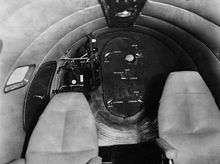Lockheed XC-35
| XC-35 | |
|---|---|
 | |
| Lockheed XC-35 | |
| Role | Experimental |
| National origin | United States |
| Manufacturer | Lockheed |
| First flight | 9 May 1937 |
| Introduction | 1937 |
| Status | In storage at the Smithsonian Institution's National Air and Space Museum |
| Primary user | United States Army Air Corps |
| Number built | 1 |
| Developed from | Lockheed Model 10 Electra |
The Lockheed XC-35 is a twin-engine, experimental pressurized airplane. It was the second American aircraft to feature cabin pressurization. It was initially described as a 'supercharged cabin' by the Army. The distinction of the world's first pressurized aircraft goes to the Engineering Division USD-9A which first flew in the United States in 1921.[1] The XC-35 was a development of the Lockheed Model 10 Electra that was designed per a 1935 request by the United States Army Air Corps for an aircraft with a pressurized cabin.[2]
Design and development
The United States Air Corps wanted the aircraft to perform high altitude research and to test the feasibility of a pressurized cabin. The Corps contracted with Lockheed Aircraft Corporation to produce the aircraft at a total cost of $112,197. The requirements called for an aircraft capable of flying at no less than 25,000 ft (7,620 m) and having an endurance of ten hours with at least two hours above 25,000 ft (7,620 m).[2] Major Carl Greene and John Younger, both structures experts who worked for the Air Corps Engineering Division at Wright Field in Ohio were responsible for the design of the pressurized cabin structure. Greene and Younger worked with Lockheed to modify a Model 10 Electra with a new fuselage consisting of a circular cross-section that was able to withstand up to a 10 psi differential.[3] New, smaller windows were used to prevent a possible blowout while operating at high pressure differentials. The cabin pressurization was provided by bleeding air from the engines' turbo supercharger, the compressor outlet fed into the cabin and was controlled by the flight engineer.[4] This system was able to maintain a cabin altitude of 12,000 ft (3,658 m) while flying at 30,000 ft (9,144 m).[5] The fuselage was divided into two compartments, a forward pressurized compartment, and an aft unpressurized compartment. The forward compartment housed two pilots, a flight engineer, and up to two passengers. The aft compartment provided accommodation for one passenger and could be used only at low altitudes since it lacked pressurization.[3]
The XC-35 was fitted with two Pratt & Whitney XR-1340-43 engines of 550 hp (410 kW) each compared to the two Pratt & Whitney R-985-13 of 450 hp (336 kW) fitted to the base Model 10 Electra. The engines featured a turbo supercharger to permit the engines to operate in thin air at high altitudes.
Operational history
The XC-35 was delivered to Wright Field, Ohio in May 1937, made its first performance flight on August 5, and was involved in an extensive flight testing program for which the Army Air Corp was awarded the Collier Trophy. The lessons learned from the XC-35 played a key role in the development of the Boeing 307 Stratoliner and the B-29 Superfortress which was to be the first mass-produced pressurized aircraft.[5]
The Air Corps brass were so confident in the new technology that they allowed the XC-35 to be used as an executive transport for Louis Johnson, the assistant secretary of war and future Secretary of Defense.[4]
In 1943, NACA pilot Herbert H. Hoover flew the XC-35 into thunderstorms to gather data on the effects of severe weather on aircraft in flight.[6]
The XC-35 was donated to the Smithsonian Institution's National Air and Space Museum in 1948 and remains there in long term storage.[2]
Specifications (Lockheed XC-35)

Data from
General characteristics
- Crew: three
- Capacity: six
- Length: 38 ft 7 in (11.8 m)
- Wingspan: 55 ft 0 in (16.8 m)
- Height: 10 ft 1 in (3.1 m)
- Wing area: 458 ft (42.6 m)
- Loaded weight: 10,500 lb (4,760 kg)
- Max. takeoff weight: lb (kg)
- Powerplant: 2 × Pratt & Whitney R-1340-43, 550 hp (410 kW) each
Performance
- Maximum speed: 236 mph (380 km/h)
- Range: 800 mi (1,285 km)
- Service ceiling: 31,500 ft (9600 m)
- Wing loading: 22.9 lb/ft² (111.7 kg/m²)
See also
- Related development
References
- ↑ Cornelisse, Diana G. Splended Vision, Unswerving Purpose; Developing Air Power for the United States Air Force During the First Century of Powered Flight. Wright-Patterson Air Force Base, Ohio: U.S. Air Force Publications, 2002. ISBN 0-16-067599-5. pp. 128–129..
- 1 2 3 Lockheed XC-35 Electra, Smithsonian Institution National Air and Space Museum.
- 1 2 Lockheed XC-35, National Museum of the Air Force.
- 1 2 Airplanes that Transformed Aviation, Air & Space Magazine.
- 1 2 Van Patten, Robert E. Air Force Magazine Online, Vol.86, No.1 January 2003
- ↑ Herbert H. Hoover & Lockheed XC-35, NASA Image eXchange Collection Archived May 21, 2009, at the Wayback Machine.
External links
| Wikimedia Commons has media related to Lockheed XC-35. |
- XC-35 in the collection of the National Air and Space Museum
- XC-35 from National Museum of the United States Air Force
- Lockheed XC-35 (10E) Electra
- Lockheed 10-E XC-35 (36-353 c/n 3501)
- XC-35 Photo Gallery from National Museum of the United States Air Force